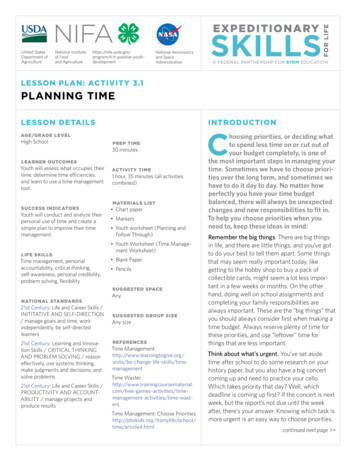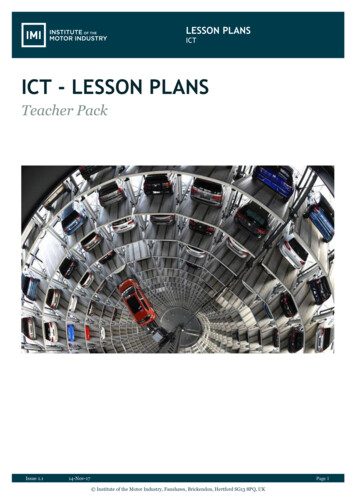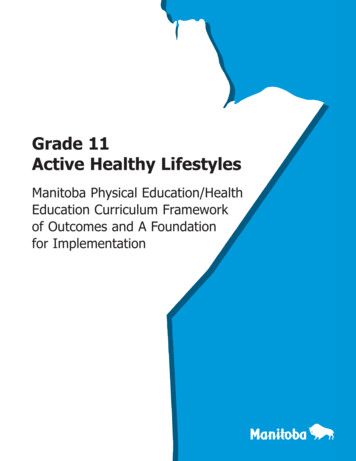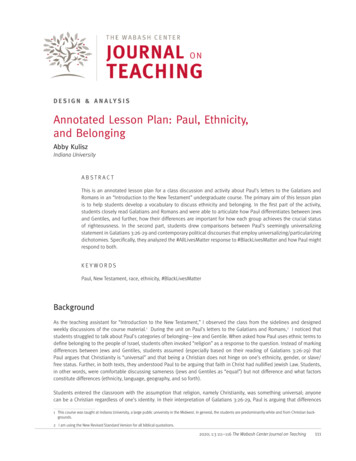
Transcription
United StatesDepartment ofAgricultureNational Instituteof Foodand ive-youthdevelopmentNational Aeronauticsand SpaceAdministrationskillsfor lifeexpeditionaryA FederAl PArtnershiP For steM educAtionlesson plan: activity 3.1planning timelesson detailsintroductionage/grade levelHigh Schoolprep tiMe30 minuteslearner outcoMesYouth will assess what occupies theirtime, determine time efficiencies,and learn to use a time managementtool.1 hour, 35 minutes (all activitiescombined)success indicators Chart paperYouth will conduct and analyze theirpersonal use of time and create asimple plan to improve their timemanagement.life skillsTime management, personalaccountability, critical thinking,self-awareness, personal credibility,problem solving, flexibilityactivity tiMeMaterials list Markers Youth worksheet (Planning andFollow Through) Youth Worksheet (Time Manage ment Worksheet) Blank Paper Pencilssuggested spacenational standardsAny21st Century: Life and Career Skills /INITITATIVE AND SELF-DIRECTION/ manage goals and time, workindependently, be self-directedlearnersAny size21st Century: Learning and Innova tion Skills / CRITICAL THINKINGAND PROBLEM SOLVING / reasoneffectively, use systems thinking,make judgments and decisions, andsolve problemsTime hange-life-skills/time management21st Century: Life and Career Skills /PRODUCTIVITY AND ACCOUNT ABILITY / manage projects andproduce resultssuggested group sizereferencesTime ames-activities/time management-activities/time-wast ersTime Management: Choose /article4.htmlChoosing priorities, or deciding whatto spend less time on or cut out ofyour budget completely, is one ofthe most important steps in managing yourtime. Sometimes we have to choose priori ties over the long term, and sometimes wehave to do it day to day. No matter howperfectly you have your time budgetbalanced, there will always be unexpectedchanges and new responsibilities to fit in.To help you choose priorities when youneed to, keep these ideas in mind:Remember the big things. There are big thingsin life, and there are little things, and you’ve gotto do your best to tell them apart. Some thingsthat may seem really important today, likegetting to the hobby shop to buy a pack ofcollectible cards, might seem a lot less impor tant in a few weeks or months. On the otherhand, doing well on school assignments andcompleting your family responsibilities arealways important. These are the “big things” thatyou should always consider first when making atime budget. Always reserve plenty of time forthese priorities, and use “leftover” time forthings that are less important.Think about what’s urgent. You’ve set asidetime after school to do some research on yourhistory paper, but you also have a big concertcoming up and need to practice your cello.Which takes priority that day? Well, whichdeadline is coming up first? If the concert is nextweek, but the report’s not due until the weekafter, there’s your answer. Knowing which task ismore urgent is an easy way to choose priorities.continued next page
skillsfor lifee x pe d i t i o n a rypag e2lesson plan: activity 3.1planning time, Continuedselves and not get burned out. continued from previous pageThink about the consequences of NOT spending time onit. Can’t decide whether something is worth your time?Ask yourself this: “What would happen if you DIDN’T doit?” For example, should you finish writing up a scienceproject or watch a movie on DVD? What are the conse quences of NOT doing your science work? What are theconsequences of NOT watching the DVD?Sometimes you know when you’ll have to choose long term priorities, like when you need to pick activities for theupcoming school year. Other times, you’re forced to dothis suddenly because your schedule has become toopacked or you have a new goal, like putting in extrabasketball practice because you want to get better atshooting. To help you make these tough choices onlong-term priorities, ask yourself these questions: What do these things mean to my life? Is this a now-or-never situation? Am I doing this for me, or for someone else?activity instructionactivity: spending tiMe (60 Minutes)1.3. Talk to the youth about the benefits of having time todo what they like to do. Tell the youth that today theywill learn some strategies for time management thatmight just give them the time to do some of thosethings.4. On chart paper, create a two-column chart with thetitle “Time.” Label one side of the column “How Ispend my time” and the other side “How I would liketo spend my time.” Model for the youth by filling in afew items on each side of the chart. Fill in examples,such as sleep, eat, school and shower on the first side.Under the second column give a few examples such asexercise and visiting friends. Have the youth give youexamples and put them on the chart.5. Handout the youth worksheet “How Do I Use MyTime?” and explain that youth are going to workindependently on all three sections of the worksheetand will have time to discuss the sections with apartner. This is going to help them understand howthey spend their own time.6. Instruct youth to complete Part I of the worksheet,which addresses how they spent their time yesterday,and Part II, which asks them to rate how well theymanage their time in relationship to school and thingslike homework.Do you ever wish you had more hours in the day to doeverything you need or want to do? If you had no timeconstraints or obligations, like school or jobs, what are 7.two things you would do with your time? Have theyouth think about these questions, pair up withanother person, and share their answer with the otherperson. After they have shared with their partner,discuss this idea as a class, sorting suggested activi ties by putting tallies into categories, such as sports/exercise, friends, volunteering, relaxing, art, and media.Discuss which categories most of the activities fallinto.2. Now, ask the youth if they can figure out how manyminutes there are in a year and then how manyminutes there have been in their lifetime (answers:525,600 minutes in a year which averages out to8,409,600 for a sixteen year old). Share with theyouth that how they use their time can help them notonly reach their goals but also have time for them At this point, stop and have the youth share their data.How much time did they actually spend on videogames, or watching TV? How much time did theyspend with friends? How much time did they spendon things they wanted to do? Compare these items tothe chart they had done before. Ask the youth to talkto their partner about where they wish they had spenttheir time when they look back from today. Ask theyouth whether there are areas where they spend toolittle time or too much time?8. Draw the youth’ attention to Part III of the worksheet.Ask youth to work with their partner to determinewhat is most important and how much time it takesup in their day. What is next important and how muchtime will that get? And finally what is least importantand how much time will it get.continued next page
skillsfor lifee x pe d i t i o n a rypag e3lesson plan: activity 3.1planning time, Continued continued from previous page9. After thinking about this, distribute a copy of the TimeManagement Handout. Read and discuss the steps ofthe action plan, and then give youth time to completethe page. Have them share this worksheet with theirpartner, discussing and adjusting their plan based onthis discussion.4. Allow youth to contemplate your question, if timeallows you can have them break into groups of 3-5and discuss what each person considered “the onething” and why?applied challenge: no tiMe to Waste(20 Minutes)10. Discuss the value of making a to-do list from theirtime-management plan. Model making a “to do” listusing your own personal goals. Show the youth how toassign a time frame and show them how to assignimportance and prioritize. Pass out blank paper andgive the youth a few minutes to create their own to-dolist.Choose four major time wasters that you discussed in yourgroup and use them in this follow-up activity to reinforcelearning and encourage youth to think of more creativeways to counter common time wasters. Some exampletime wasters can be: drop in visitors, travel time, tele phone, and watching TV.Discuss:1. How might adopting good time management skillsaffect your lives? What might be different?2.How does applying time management skills affect your 3.energy?4.What are some “unnecessary activities” that take up5.your time that you wish you didn’t spend time onbecause they distract you from your goals or take6.away your energy? What are some “unnecessary activities” that arepositive and help you to be more productive becausethey energize you? How might today’s work help you find time for thingsyou want to do?debrief activity: action replay(15 Minutes)1.Directions:Everyone should sit down (typically on the floor orground)2. Suggest that everyone close their eyes and create apicture in their mind as the facilitator replays the activ ity. NOTE: add sufficient detail but don’t take a lot oftime3. When you have finished recapping the activity, askeveryone to choose one thing that stood out them andconsider why it stood out?7.Write down each time waster on the back of anenvelope. (One time waster on each envelope.)Add 4 blank index cards to each envelope.Divide youth into 4 teams.Issue one envelope to each group.Point out to the groups the time waster written on theback of the envelope and the index cards inside.In each round, each team is tasked to come up with asmany ideas as possible to handle their time waster,write that on one of the index cards, replace it insidethe envelope and pass the envelope to the next team.Each round has a time limit of three minutes, so oncetime is up on each round, every team has to pass theenvelope to the next team.8. Go on for two or three rounds or as your time permits.9. Ask each team to present the ideas for the time wasterfrom the envelope they currently have in front of thewhole group.Variation: Hold an evaluation round of voting for which ofthe proposed strategies works best in terms of practicalityand usefulness.
skillsfor lifee x pe d i t i o n a rypag e4lesson plan: activity 3.1planning time, ContinuedhoW do i use My tiMe?Part I.Think back over the last 24 hours and calculate how time you have spent on the following activities. Blanks are providedfor you to add other categories if needed.I spentminutes on sleeping.minutes with my family.minutes eatingminutes on TV or video games.minutes talking to my friendsminutes onminutes on activitiesminutes onPart II.Now let’s test how you spend your time on school. If your answer to the question below is always, put down a 3. If youranswer is sometimes, put a 2. If your answer is probably not, put a 1.1. I have a regular time for studying each day.2. I write my assignments down and check the list regularly.3. I always have the materials I need when I start to study.4. I rarely distract myself with wandering away from the task when studying.5. I do assignments in chunks to avoid last minute work.Part III.Reflect on how you answered the questions above and fill out the chart below.What are the things that I could do only sometimes,certainly not every day?What are the things that I need to do regularly every day?What are the really important things that need moretime?
skillsfor lifee x pe d i t i o n a rypag e5lesson plan: activity 3.1planning time, ContinuedtiMe ManageMentDo you feel you manage your time well? Vote Now! Yes, I’m good at scheduling my days and weeks. Sometimes I’m short on time, sometimes not. No, I am almost always short on time.How much time do you set aside for homework every night? Take a guess at how much time it will take for you to getyou work done. Write it down. Then, right before you get started, check the clock and see what time it is. You are goingto time yourself and see how close your guess was. You may want to do this a few times to help you become aware ofhow long it actual takes to do your homework.Do you have a routine? Routines are a great way to help you get everything done on time. Before doing anything, plan itand what you have to do first according to its importance. And no matter what happens; do not allow these distractionsto become your priority.How do you establish a routine?1.Write down the things you need to accomplish2. Every item written on your list must be given a time frame3. Organize every item written according to its importance.4. Make a plan on how to achieve your goals in the given time frame5. Focus. This will help you accomplish every little thing you have to do for a day.tiMe ManageMent action plan1.Clarify your goal. (Can you get a visual picture of the expected outcome? How can you see if you have reached yourdestination? What makes your goal measurable? What might be in the way, like the limits on time, money, or otherresources?) On a blank piece of paper, clearly state your goal.2. Write a list of actions. Write down all actions you may need to take to achieve your goal. At this step, focus ongenerating and writing as many different options and ideas as possible. List them under your goal.3. Analyze, prioritize, and prune. Look at your list of actions. What are the absolutely necessary and best steps toachieve your goal? Mark them with a check mark. After that, what action items can be dropped from in the planwithout significant consequences for the outcome? Cross them out.4. Organize your list into a plan. Decide on the order of your action steps. Start from looking at your checked keyactions. For each action, what other steps should be completed before that action? Rearrange your actions andideas into a sequence of ordered action steps. Finally, look at your plan once again. Are there any ways to simplify iteven more?5. Monitor the execution of your plan and review the plan regularly. How much have you progressed toward your goalby now? What new information have you got? Use this information to further adjust and optimize your plan.
skillsfor lifeskillse xpe dition aryfor lifeexpeditiona ryactivity 3.1: learner assessMentactivity 3.1: learner assessMentThese questions are about things you learned during thisactivity. Please check the circle that best describes you.These questions are about things you learned during thisactivity. Please check the circle that best describes you.Q2Q3Q1I understand how to set priorities with my time.Not at all like meA little like meSomewhat like meA lot like meQ2I can identify two things I do that are considered timewasters.Not at all like meA little like meSomewhat like meA lot like meI can identify three strategies to help me better managemy time.Q3Not at all like meA little like meSomewhat like meA lot like meI understand how to set priorities with my time.Not at all like meA little like meSomewhat like meA lot like meI can identify two things I do that are considered timewasters.Not at all like meA little like meSomewhat like meA lot like meI can identify three strategies to help me better managemy time.Not at all like meA little like meSomewhat like meA lot like meskillse xpe dition aryfor lifeexpeditiona ryskillsfor lifeQ1activity 3.1: learner assessMentactivity 3.1 learner assessMentThese questions are about things you learned during thisactivity. Please check the circle that best describes you.These questions are about things you learned during thisactivity. Please check the circle that best describes you.Q1Q2Q3I understand how to set priorities with my time.Not at all like meA little like meSomewhat like meA lot like meI can identify two things I do that are considered timewasters.Not at all like meA little like meSomewhat like meA lot like meI can identify three strategies to help me better managemy time.Not at all like meA little like meSomewhat like meA lot like meQ1Q2Q3I understand how to set priorities with my time.Not at all like meA little like meSomewhat like meA lot like meI can identify two things I do that are considered timewasters.Not at all like meA little like meSomewhat like meA lot like meI can identify three strategies to help me better managemy time.Not at all like meA little like meSomewhat like meA lot like me
success indicators . Youth will conduct and analyze their personal use of time and create a simple plan to improve their time management. life skills . Time management, personal accountability, critical thinking, self-awareness, personal credibility, problem solving, lexibility . national standards











